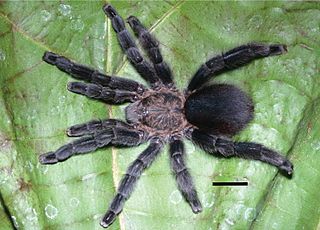
Avicularia is a genus of the family Theraphosidae containing various species of arboreal tarantulas. The genus is native to Panama, the Caribbean and tropical South America. Each species in the genus has very distinguishable pink foot pads.

The Antilles pinktoe tarantula, also known as the Martinique red tree spider or the Martinique pinktoe, is popular as a pet spider because of its docile character and unique coloration.
Euathlus affinis is a species of spider belonging to the family Theraphosidae (tarantulas). It is native to Chile.
Grammostola anthracina is a species of spider belonging to the family Theraphosidae (tarantulas). It is found in Uruguay, Paraguay, Brazil, and Argentina.

The Aviculariinae are a subfamily of spiders in the family Theraphosidae (tarantulas). They can be distinguished from other theraphosids by a number of characters. Their legs have no or few spines on the underside of the tibial and metatarsal joints of the legs. The last two leg joints have brushes of hairs (scopulae) that extend sideways, particularly on the front legs, giving them a spoon-like (spatulate) appearance. Females have two completely separated spermathecae.

Typhochlaena is a genus of small-bodied tarantulas with an arboreal trapdoor lifestyle. All the species except for T. seladonia were first described by Rogério Bertani in 2012.

Typhochlaena paschoali is a species of tarantula, in the subfamily Aviculariinae. It is native to Brazil.

Typhochlaena seladonia is a species of aviculariine tarantula, and is the type species of the genus Typhochlaena. It is unique as an arboreal spider that constructs trapdoors in the bark of trees.

Pachistopelma bromelicola is a species of tarantula, contained within the Aviculariinae subfamily. It is endemic to Brazil.

Antillena is a genus of spiders in the family Theraphosidae (tarantulas). As of March 2017, the genus contained a single species, Antillena rickwesti, found in the Dominican Republic.

Caribena is a genus of spiders in the family Theraphosidae (tarantulas), found in the Antilles. The two species accepted as of March 2017 were formerly placed in Avicularia. Apart from a different distribution – Avicularia species are found in mainland South and Central America – Caribena is distinguished by having longer and thinner type II urticating hairs in a conspicuous patch on the upper surface of the abdomen. Males also have a differently shaped palpal bulb.

Avicularia juruensis is a species of spider in the family Theraphosidae, found in South America. Avicularia urticans was brought into synonymy in 2017. It has been given the English name Amazonian pink toe spider. Under the synonym Avicularia urticans, it is also known as the Peruvian pinktoe tarantula. It is a large mygalomorph spider, with a maximum body length over 30 mm (1.2 in) and the longest fully extended leg about 60 mm (2.4 in). Like other species in the genus Avicularia, specimens under this name are sold as pets, although their identity has not been confirmed by taxonomic studies.

Avicularia variegata is a species of spider in the family Theraphosidae found in Venezuela and Brazil. Previously described as Avicularia avicularia variegata, it is synonymous with Avicularia bicegoi.

Avicularia rufa is a species of spider in the family Theraphosidae. Specimens from the Brazilian states of Mato Grosso and Rondônia have regularly been misidentified as Avicularia juruensis. One difference is the vivid yellow rings on the legs of A. rufa compared to the paler rings of A. juruensis.

Avicularia lynnae is a species of spiders in the family Theraphosidae, found in Ecuador and Peru. It was first described in 2017. The specific name refers to Lynn West, wife of mygalomorph expert Rick C. West.

Avicularia caei is a species of spiders in the family Theraphosidae found in Brazil. It was first described in 2017. The specific name honours Carlos Eduardo Gurgel Paiola, known as "Caê".
Avicularia glauca is a species of spider in the family Theraphosidae, found in Panama. The species was first described by Eugène Simon in 1891. As of March 2017, only a single female preserved specimen is known. It appears to be closely related to Avicularia purpurea. Avicularia species are rare in southern Central America; further studies are in progress.

Ybyrapora gamba is a species of spider in the family Theraphosidae, found in Brazil.

Ybyrapora sooretama is a species of spider in the family Theraphosidae, found in Brazil.
Yanomamius is a genus of South American tarantulas first erected by Rogério Bertani and M. Q. Almeida in 2021 for two newly discovered species and one previously described species from Brazil. In one of Bertani's prior studies, he investigated a tarantula collected by the Yanomami as a source of food. Based on the limited material available for study- two adult females and one immature spider- the species was placed into Holothele. The next year, it was moved to newly erected genus Guyruita due, in part, to the multi-lobed shape of its spermathecae. When the first male was found and described, the diagnostic characteristics didn't match that of Holothele or Guyruita, so a new genus was erected for Y. waikoshiemi and three other closely related species.




















